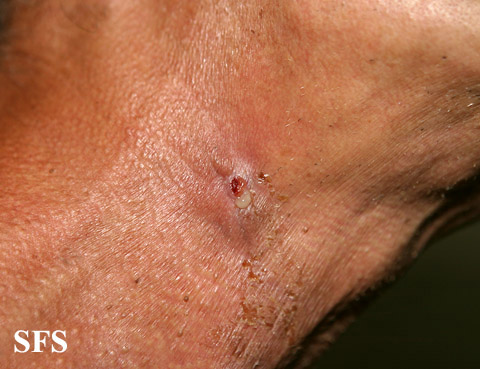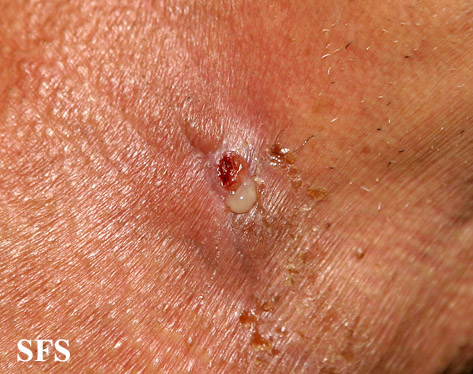Laryngeal cancer physical examination: Difference between revisions
Jump to navigation
Jump to search
No edit summary |
No edit summary |
||
| Line 5: | Line 5: | ||
==Overview== | ==Overview== | ||
==Physical Examination== | ==Physical Examination== | ||
===Appearance of the Patient=== | |||
*Patients with laryngeal carcinoma are usually well appearing | |||
===Ears=== | |||
*There may be diminished hearing | |||
===Throat=== | |||
*The throat may be erythematous | |||
===Neck=== | |||
*Neck swelling may be present | |||
*Swollen lymph nodes may be present | |||
*Laryngeal crepitus may be present | |||
===Lungs=== | |||
*[[Stridor]] may be present due to partial airway obstruction | |||
==Extremities== | |||
Painful [[paronychia]] in association with a scaly, erythematous, keratotic rash (papules and plaques) of the ears, nose, fingers, and toes, may be indicative of [[acrokeratosis paraneoplastica]], which is associated with [[squamous cell carcinoma]] of the [[larynx]] | |||
===Gallery=== | ===Gallery=== | ||
<gallery> | <gallery> | ||
| Line 29: | Line 37: | ||
{{WikiDoc Sources}} | {{WikiDoc Sources}} | ||
[[Category:Disease]] | [[Category:Disease]] | ||
[[Category:Types of cancer]] | [[Category:Types of cancer]] | ||
Revision as of 14:10, 27 October 2015
|
Laryngeal cancer Microchapters |
|
Diagnosis |
|---|
|
Treatment |
|
Case Studies |
|
Laryngeal cancer physical examination On the Web |
|
American Roentgen Ray Society Images of Laryngeal cancer physical examination |
|
Risk calculators and risk factors for Laryngeal cancer physical examination |
Editor-In-Chief: C. Michael Gibson, M.S., M.D. [1]; Associate Editor(s)-in-Chief: Jesus Rosario Hernandez, M.D. [2].
Overview
Physical Examination
Appearance of the Patient
- Patients with laryngeal carcinoma are usually well appearing
Ears
- There may be diminished hearing
Throat
- The throat may be erythematous
Neck
- Neck swelling may be present
- Swollen lymph nodes may be present
- Laryngeal crepitus may be present
Lungs
- Stridor may be present due to partial airway obstruction
Extremities
Painful paronychia in association with a scaly, erythematous, keratotic rash (papules and plaques) of the ears, nose, fingers, and toes, may be indicative of acrokeratosis paraneoplastica, which is associated with squamous cell carcinoma of the larynx

